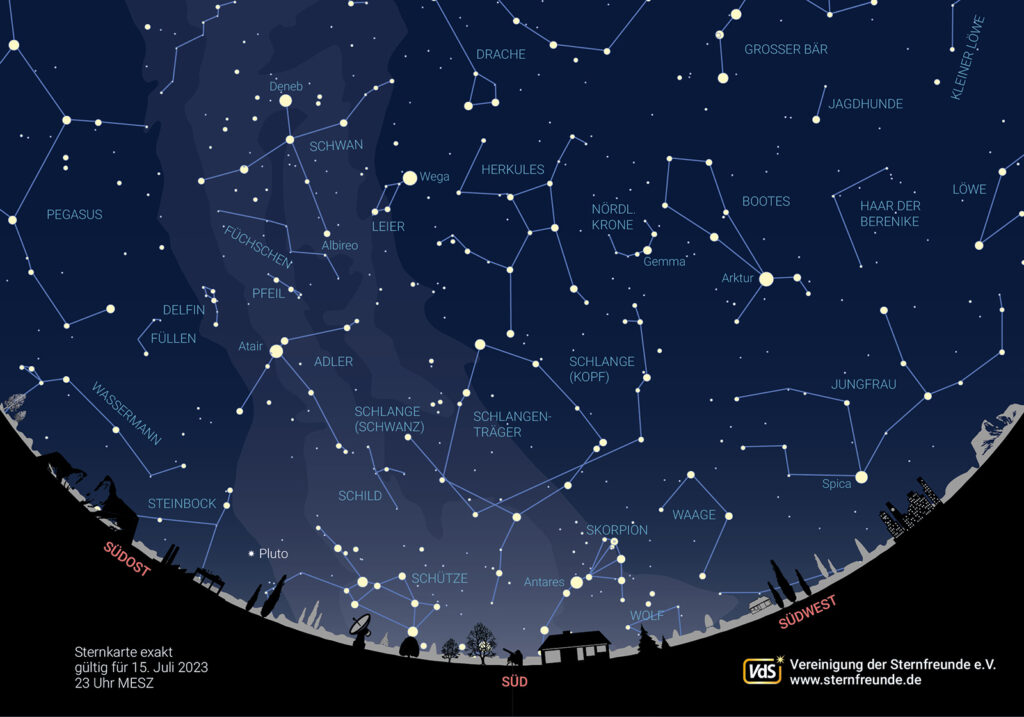The starry sky in July 2023
The summer starry sky has arrived. After dark, the so-called Summer triangleconsisting of the bright stars Vega in Lyra, Deneb in the Swan and the slightly lower star Atair (also known as Altair) in the Eagle. On clear nights, away from the disturbing scattered light of the city, the Band of the Milky Way. It runs from the north east across the celestial W of Cassiopeia, across the Swan and on through the constellation of the Eagle. However, the full moon in the days before and after July 3 disturbs the beautiful view. Around August 12/13, it will be worth taking a walk in the sky with your eyes or binoculars to admire the Milky Way or look out for shooting stars on the occasion of the Perseids.
SUN AND MOON
After the summer solstice on June 21, the nights become longer again. If the sun sets at 21:43 CEST on the first of the month, it will set at 21:23 CEST at the end of the month. Early risers can observe the moon's visit to Saturn, the Roman god of agriculture, at around 4 a.m. on July 7. On July 12 at around 2 a.m., it will pay a visit to the planet Jupiter.
PLANETS
Named after the messenger of the gods Mercurius, the Mercury hides behind our mother star, the sun, at the beginning of the month. The distance of 26 degrees at the end of the month is not sufficient for evening visibility.
Venus shines in its greatest brilliance in the western evening sky on July 7. As a result, it has often been mistaken for a UFO and excited inquiries have been made to astronomy clubs and the media. During the course of the month, its setting is considerably earlier. From the 25th, you will look in vain for the goddess of love. She will not appear in the morning sky again until the end of August.
Mars, the god of war of the ancient Romans, gives his evening performance.
Jupiter becomes a planet of the second half of the night, but is not yet interesting enough.
Saturn will almost become a transiting star for the whole night at the end of the month. The opposition at the end of August can already be guessed.
Uranus is developing into a planet of the second half of the night.
Neptune continues to rise prematurely, but meaningful observation is still not possible.
STARRY SKY
As a substitute for the planet-poor evening sky at the end of July to mid-August, the summer starry sky now shows itself in all its splendor.
On Western sky Bootes, the bear's keeper, can still be observed with the bright star Arcturus.
Starting on Northern sky the constellation of the dragon winds its way southwards across the western sky, circling Polaris with the Little Dipper. The head of the dragon is located directly above the constellation Hercules. One of the legends says that the dragon Ladon was defeated by Hercules and then placed in the sky as a constellation by the goddess Hera.
In the East Pegasus stretches its head above the layers of haze near the horizon. To the north-east of the eagle is the small constellation of the dolphin, which can be seen from the entire inhabited part of the earth due to its proximity to the celestial equator.
The Southern sky continues to show us the prominent Scorpio and Sagittarius. Both constellations are only just above the horizon in Germany. Above them are the inconspicuous constellations of the Serpent Bearer and the Serpent.
About us are the conspicuous constellations Swan and Lyra, as well as the faint constellation Hercules.

